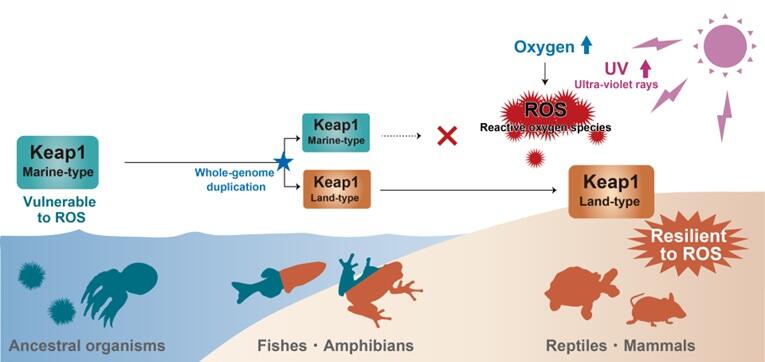All living organisms on Earth once lived in the sea, but at some point, they moved to the land. The evolution from gill breathing to lung breathing to move onto land is well known, but another important factor is that organisms acquired resistance to reactive oxygen species (ROS). Oxygen concentrations are higher on land than in the sea, and the direct exposure of the body to ultraviolet radiation leads to the production of ROS, the toxicity of which makes it impossible for marine organisms to survive on land.
A research group led by Distinguished Professor Keiichi Nakayama and Assistant Professor Kanae Yumimoto of the Department of Molecular and Cellular Biology, Medical Institute of Bioregulation, at Kyushu University, has discovered a new evolutionary mechanism that allowed animals to adapt to the higher concentrations of ROS on land. The ubiquitin ligase Keap1 acquired high resistance to ROS by modifying its own structure. The results were published in Science Advances.

Provided by Kyushu University
Nrf2 is a key transcription factor that protects cells from oxidative damage by inducing the expression of antioxidative proteins. Keap1 suppresses the response to ROS by promoting the ubiquitination of Nrf2, leading to its degradation. In other words, the higher the level of Nrf2 expression, the stronger the defense against ROS will be. The Keap1 protein is a complex-type ubiquitin ligase that acquires ubiquitination function only after binding to the Cul3 protein.
Nakayama explained, "We are researching various protein degradation systems; but among them, only the Keap1 and Cal3 proteins possessed by terrestrial organisms have a weak binding force. We wondered why this was the case, which led to our research."
Structural analysis revealed that part of the human Keap1 protein has a unique structure that makes it difficult to bind to Cal3. Therefore, by tracing the evolution of Keap1 molecules, thr group found that marine-type Keap1 in pre-chordates has strong Nrf2-degrading activity, and thus suppresses the amount of Nrf2.
As a result of genome duplication during evolution, fish and amphibians possess two types of Keap1: marine type and terrestrial type. However, terrestrial organisms that emerged after reptiles only possess terrestrial-type Keap1. This indicates that vertebrates evolved from having marine-type Keap1 to terrestrial-type Keap1 during the transition to land, thereby weakening the Nrf2-degrading activity and acquiring a strong defense against ROS.
To prove this hypothesis, the research group produced genetically modified mice in which terrestrial-type Keap1 was replaced with marine-type Keap1. When the neonatal mice were exposed to ultraviolet radiation at the same level as natural sunlight (sunlight in Fukuoka at around November), most of the normal mice survived, whereas the mice with marine-type Keap1 could not process the generated ROS and almost died. This indicates that if the marine-type Keap1 gene had not evolved into the terrestrial-type Keap1 gene, animals— including humans—would not have been able to live on land.
The results of this study shed light on part of the mystery of the evolution of life. In addition to its defense against ROS, the Keap1-Nrf2 pathway is also a defense against various toxic substances present in land plants, and the evolution of Keap1 may also be a countermeasure against such substances.
This article has been translated by JST with permission from The Science News Ltd. (https://sci-news.co.jp/). Unauthorized reproduction of the article and photographs is prohibited.




